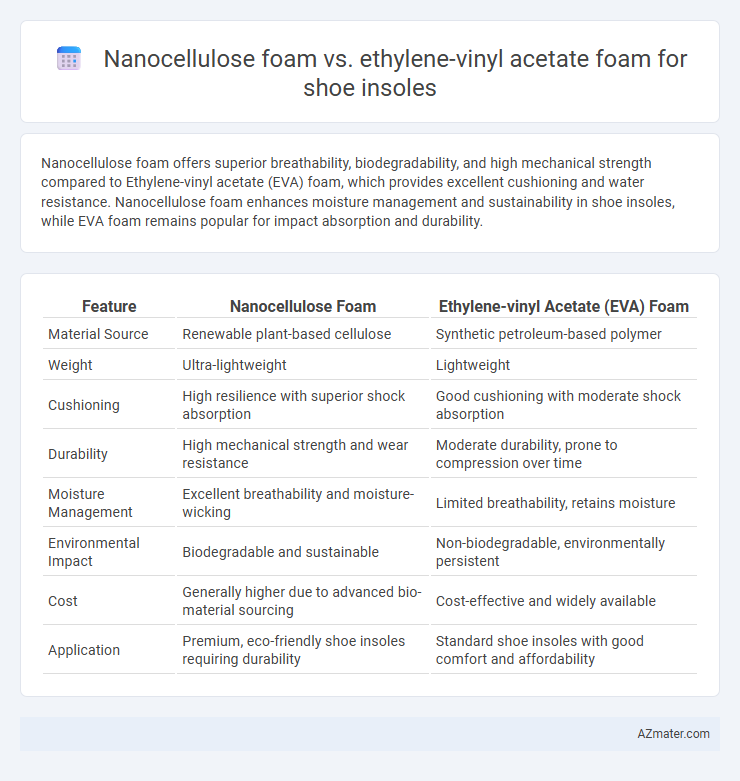Nanocellulose foam offers superior breathability, biodegradability, and high mechanical strength compared to Ethylene-vinyl acetate (EVA) foam, which provides excellent cushioning and water resistance. Nanocellulose foam enhances moisture management and sustainability in shoe insoles, while EVA foam remains popular for impact absorption and durability.
Table of Comparison
| Feature | Nanocellulose Foam | Ethylene-vinyl Acetate (EVA) Foam |
|---|---|---|
| Material Source | Renewable plant-based cellulose | Synthetic petroleum-based polymer |
| Weight | Ultra-lightweight | Lightweight |
| Cushioning | High resilience with superior shock absorption | Good cushioning with moderate shock absorption |
| Durability | High mechanical strength and wear resistance | Moderate durability, prone to compression over time |
| Moisture Management | Excellent breathability and moisture-wicking | Limited breathability, retains moisture |
| Environmental Impact | Biodegradable and sustainable | Non-biodegradable, environmentally persistent |
| Cost | Generally higher due to advanced bio-material sourcing | Cost-effective and widely available |
| Application | Premium, eco-friendly shoe insoles requiring durability | Standard shoe insoles with good comfort and affordability |
Introduction to Nanocellulose Foam and Ethylene-Vinyl Acetate Foam
Nanocellulose foam is a lightweight, biodegradable material derived from natural cellulose fibers, offering exceptional mechanical strength and excellent breathability ideal for environmentally friendly shoe insoles. Ethylene-vinyl acetate (EVA) foam is a synthetic polymer known for its durability, flexibility, and shock absorption, widely used in shoe insoles to provide cushioning and support. Comparing these materials highlights nanocellulose foam's sustainability and breathability against EVA foam's resilience and comfort performance in footwear applications.
Material Composition and Structure
Nanocellulose foam is composed of cellulose fibers derived from plant sources, offering a highly porous, lightweight, and biodegradable structure with superior breathability and moisture-wicking properties. Ethylene-vinyl acetate (EVA) foam consists of a copolymer of ethylene and vinyl acetate, characterized by a closed-cell, flexible, and resilient structure that provides excellent shock absorption and cushioning. The nanocellulose foam's network-like, hydrophilic matrix contrasts with EVA's hydrophobic, dense cellular structure, influencing their respective comfort, durability, and environmental impact in shoe insole applications.
Sustainability and Environmental Impact
Nanocellulose foam offers superior sustainability compared to Ethylene-vinyl acetate (EVA) foam due to its renewable biomass origin and biodegradability, reducing plastic waste accumulation in landfills. EVA foam, derived from non-renewable petroleum resources, exhibits limited recyclability and contributes to long-term environmental pollution through microplastic release. Incorporating nanocellulose foam in shoe insoles significantly lowers carbon footprint and supports circular economy principles by enabling compostable and eco-friendly footwear alternatives.
Cushioning and Comfort Performance
Nanocellulose foam offers superior cushioning and breathability compared to Ethylene-vinyl acetate (EVA) foam, providing enhanced shock absorption and moisture management for shoe insoles. The lightweight and highly porous structure of nanocellulose foam ensures better pressure distribution and reduces foot fatigue over extended wear. In contrast, EVA foam, while durable and flexible, tends to have lower breathability and less effective moisture-wicking properties, potentially leading to reduced comfort during prolonged use.
Breathability and Moisture Management
Nanocellulose foam offers superior breathability compared to ethylene-vinyl acetate (EVA) foam due to its highly porous structure, facilitating enhanced air circulation within shoe insoles. Its hydrophilic nature enables efficient moisture absorption and wicking, reducing sweat accumulation and promoting foot dryness. In contrast, EVA foam exhibits lower breathability and moisture management, often leading to increased heat retention and discomfort during prolonged wear.
Durability and Wear Resistance
Nanocellulose foam exhibits superior durability and wear resistance compared to Ethylene-vinyl acetate (EVA) foam, owing to its high tensile strength and enhanced structural stability at the nanoscale. While EVA foam offers excellent cushioning and flexibility, it tends to compress and degrade faster under prolonged wear conditions, leading to reduced lifespan in shoe insoles. The nanocellulose reinforcement provides greater resistance to mechanical stress and deformation, making it a more sustainable choice for long-lasting footwear applications.
Weight and Flexibility Comparison
Nanocellulose foam offers a significantly lighter weight compared to Ethylene-vinyl acetate (EVA) foam, enhancing overall comfort for shoe insoles by reducing foot fatigue. The superior flexibility of nanocellulose foam allows for better adaptability to foot movements, providing improved shock absorption and cushioning. While EVA foam is durable and moderately flexible, nanocellulose foam's lightweight and exceptional flexibility make it a preferable choice for performance-focused shoe insoles.
Manufacturing Processes and Scalability
Nanocellulose foam for shoe insoles involves a bio-based, environmentally friendly manufacturing process utilizing cellulose nanofibers through processes like freeze-drying or chemical crosslinking, which can be energy-intensive and currently limited in large-scale production. Ethylene-vinyl acetate (EVA) foam is produced via polymerization and foaming techniques such as injection molding or compression molding, allowing for highly scalable, cost-effective mass production with consistent quality. Scalability challenges for nanocellulose foam stem from raw material variability and complex processing, whereas EVA foam benefits from established industrial infrastructure supporting high-volume output.
Cost Implications and Market Availability
Nanocellulose foam, known for its superior biodegradability and mechanical strength, often incurs higher production costs due to complex manufacturing processes and limited large-scale availability compared to Ethylene-vinyl acetate (EVA) foam. EVA foam dominates the shoe insole market with widespread availability and established supply chains, resulting in lower unit costs and cost-efficient production for mass-market footwear. Cost implications favor EVA foam for budget-conscious applications, while nanocellulose foam targets premium segments seeking sustainable alternatives despite current scalability constraints.
Future Trends and Innovations in Shoe Insole Materials
Nanocellulose foam exhibits exceptional biodegradability and mechanical strength, positioning it as a sustainable alternative to ethylene-vinyl acetate (EVA) foam traditionally used in shoe insoles. Innovations in nanocellulose composites enhance cushioning and moisture management, addressing EVA's limitations in environmental impact and durability. Future trends emphasize integrating nanocellulose with smart materials to create adaptive, eco-friendly insoles that improve comfort while reducing carbon footprints.

Infographic: Nanocellulose foam vs Ethylene-vinyl acetate foam for Shoe insole
 azmater.com
azmater.com